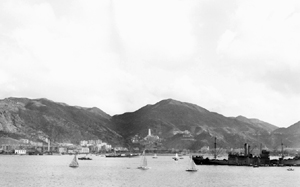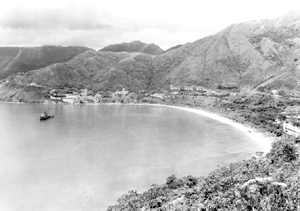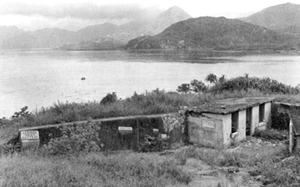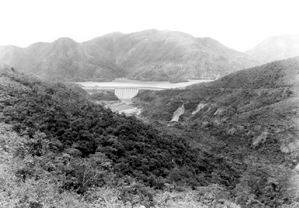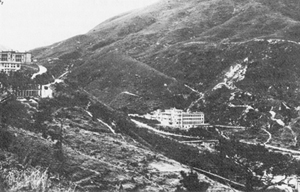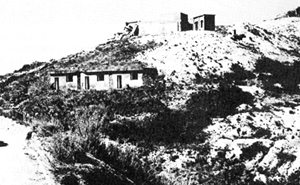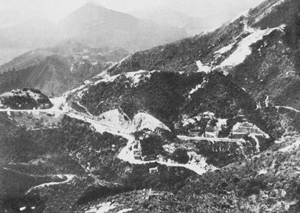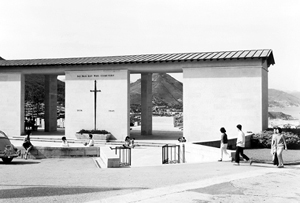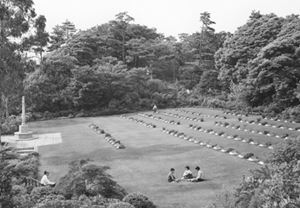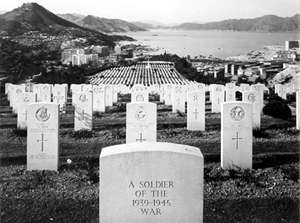Canadians in Hong Kong
This publication is available upon request in alternate formats.
PDF Version
The Defence of Hong Kong
In the Second World War, Canadian soldiers first engaged in battle while defending the British Crown Colony of Hong Kong against a Japanese attack in December 1941. The Canadians at Hong Kong fought against overwhelming odds and displayed the courage of seasoned veterans, though most had limited military training. They had virtually no chance of victory, but refused to surrender until they were overrun by the enemy. Those who survived the battle became prisoners of war (POWs) and many endured torture and starvation by their Japanese captors.
In October 1941, the Royal Rifles of Canada and the Winnipeg Grenadiers were ordered to prepare for service in the Pacific. From a national perspective, the choice of battalions was ideal. The Royal Rifles were a bilingual unit from the Quebec City area and, together with the Winnipeg Grenadiers, both battalions represented eastern and western regions of Canada. Command of the Canadian force was assigned to Brigadier J.K. Lawson. This was also a good choice because of Lawson's training and experience; he was a "Permanent Force" officer and had been serving as Director of Military Training in Ottawa. The Canadian contingent was comprised of 1,975 soldiers, which also included two medical officers, two Nursing Sisters, two officers of the Canadian Dental Corps with their assistants, three chaplains, two Auxiliary Service Officers, and a detachment of the Canadian Postal Corps. There was also one military stowaway who was sent back to Canada.
Prior to duty in Hong Kong, the Royal Rifles had served in Newfoundland and Saint John, New Brunswick, while the Winnipeg Grenadiers had been posted to Jamaica. In these locations, both battalions had received only minimal training. In late 1941, war with Japan was not considered imminent and it was expected that the Canadians would see only garrison (non-combat) duty. Instead, in December, the Japanese military launched a series of attacks on Pearl Harbor, Northern Malaya, the Philippines, Guam, Wake Island and Hong Kong. The Royal Rifles and the Winnipeg Grenadiers would find themselves engulfed in hand-to-hand combat against the Japanese 38th Division.
The defence of Hong Kong was made at a great human cost. Approximately 290 Canadian soldiers were killed in battle and, while in captivity, approximately 264 more died as POWs, for a total death toll of 554. In addition, almost 500 Canadians were wounded. Of the 1,975 Canadians who went to Hong Kong, more than 1,050 were either killed or wounded. This was a casualty rate of more than 50%, arguably one of the highest casualty rates of any Canadian theatre of action in the Second World War.
Hong Kong Prepares
The British Crown Colony of Hong Kong consisted of Hong Kong Island and the adjacent mainland areas of Kowloon and the New Territories. The region is very mountainous, with a total area of about 1,060 square kilometres.
British Prime Minister Winston Churchill and his chiefs of staff recognized that, in the event of a war with Japan, it would be impossible to hold Hong Kong. Churchill and his army chiefs designated Hong Kong an outpost, and initially decided against sending more troops to the colony. In September 1941, however, they reversed their decision and argued that additional reinforcements would provide a military deterrent against the Japanese, and reassure Chinese leader Chiang Kai Shek that Britain was genuinely interested in defending the colony. Canada was asked to provide one or two battalions for that purpose.
The Royal Rifles of Canada and the Winnipeg Grenadiers sailed from Vancouver on October 27, 1941, aboard the Awatea, escorted by HMCS Prince Robert. The Canadians arrived in Hong Kong on November 16. However, the 212 vehicles assigned to the force being transported on board the freighter Don Jose never did reach Hong Kong. The ship had only just reached Manila when the war with Japan began, and the United States forces were given approval to use the Canadian equipment in the defence of the Philippines.
To defend the colony, General C.M. Maltby had only a total force of some 14,000 soldiers and a token number of naval and air force personnel. Along with the Canadians, the military force included the 8th and 12th Coast Regiments, the 5th Anti-Aircraft Regiment of the Royal Artillery (RA), the 1st Hong Kong Regiment, the Hong Kong and Singapore Royal Artillery, the 965th Defence Battery, RA, and the 22nd and 40th Fortress Companies, Royal Engineers. Most of these units were military personnel from either India or China. There was one battalion of British infantry (the 2nd Battalion, Royal Scots), one British machine gun battalion (the 1st Battalion, Middlesex Regiment), and two Indian infantry battalions (5th Battalion, 7th Rajput Regiment and the 2nd Battalion, 14th Punjab Regiment). Indian and Chinese soldiers accounted for 35% of the entire force.
The colony had no significant air or naval defence. The Kai Tak Royal Air Force (RAF) base on Hong Kong had only five airplanes: two Walrus amphibians and three Vickers Vildebeeste torpedo bombers, flown and serviced by seven officers and 108 airmen. An earlier request for a fighter squadron had been rejected, and the nearest fully-operational RAF base was in Kota Bharu, Malaya, nearly 2,250 kilometres away.
Hong Kong also lacked adequate naval defence. All major naval vessels had been withdrawn, and only one destroyer, HMS Thracian, several gunboats and a flotilla of motor torpedo boats remained.
The arrival of the Canadians changed the plans for the defence of the colony. The original strategy had called for the main defence to be on the island with only one infantry battalion deployed on the mainland for demolition duties and for delaying purposes. The two additional battalions enabled General Maltby to assign three battalions to the mainland. These battalions would fight from the "Gin Drinkers' Line", 18 kilometres of defences stretching across rugged hill country and studded with trenches and pillboxes (concrete bunkers). It was hoped that these additional battalions would protect Kowloon, Victoria harbour, Lye Mun Passage, and the northern areas of Hong Kong Island from artillery fire launched from the mainland. If the enemy launched a major offensive, the mainland battalions would be ordered to complete demolitions, clear vital supplies and sink any remaining ships in the harbour so they would not fall into enemy hands. The remaining forces on Hong Kong Island were to prepare against any Japanese attack from the sea.
The Mainland Brigade, commanded by Brigadier C. Wallis, was composed of the Royal Scots and the two Indian battalions. The Canadian signal section was allotted to this brigade. The Island Brigade, under Brigadier Lawson, consisted of the two Canadian battalions and the Middlesex Regiment. The Canadian units, facing the sea, were assigned the task of defending the island's beaches as their primary role, while the Middlesex unit had the task of holding the system of pillboxes around the island. During the three weeks between their arrival and the outbreak of war, the Canadians stationed on the mainland engaged in intensive training on the island to familiarize themselves with the ground they would be defending. Although the preparation was for beach defence, the reconnaissance and exercises provided some knowledge of the difficult terrain, and would later prove valuable against the enemy.
Through late November and early December, life in the colony went along as usual. Reports of Japanese troops massing to the north of the Chinese border continued to be reported, but there had been many false alarms and an air of optimism prevailed. As late as December 7, a report of Japanese concentrations in the area was described as "certainly exaggerated" and "deliberately fostered by the Japanese."
The next day the Japanese attacked Hong Kong.
The Invasion
The Japanese attack did not take the garrison by complete surprise; the defence forces were prepared. On the morning of December 7, the entire garrison was ordered to war stations. The Canadian force was ferried across from Kowloon to the island, and by 5 p.m. the battalions were in position and Brigadier Lawson's headquarters was set up at Wong Nei Chong Gap in the middle of the island. Fifteen hours before the Japanese attacked, all Hong Kong defence forces were in position.
On December 8, at 8 a.m., Japanese aircraft attacked the Kai Tak airport and easily damaged or destroyed the few aircraft of the Royal Air Force. The nearly-empty camp at Sham Shui Po was the next target, where two men of the Royal Canadian Signals were wounded. They were the first Canadian casualties in Hong Kong.
That same morning, the Japanese ground forces moved across the frontier of the New Territories and met resistance from the forward forces of the Mainland brigade. In the face of strong enemy pressure these advance units fell back to the Gin Drinkers' Line. The defenders hoped to defend the line for a week or more but, on December 9, the Japanese captured Shing Mun Redoubt, an area of high ground and the most important strategic position on the left flank of the Gin Drinker's Line. The Japanese had launched their attack under cover of darkness and there was fierce fighting, but in the end the Japanese were victorious. Their victory at night revealed how General Maltby had completely underestimated his enemy. In a dispatch he had noted that "Japanese night work was poor." But within hours of their first attack, Shing Mun Redoubt was in enemy hands.
On December 10, "D" Company of the Winnipeg Grenadiers was dispatched to strengthen the remaining defenders on the mainland. On December 11, this company exchanged gunfire with the enemy and became one of the first Canadian Army units to engage in combat in the Second World War.
Further Japanese attacks followed and the Gin Drinkers' Line could no longer be held. Midday on December 11, General Maltby ordered the mainland troops to withdraw from the mainland. The Winnipeg Grenadiers covered the Royal Scots' withdrawal down the Kowloon Peninsula. The Punjabs moved at night and the Rajputs, who had been left to guard Devil's Peak, followed. The evacuation was successful and most of the Brigade's heavy equipment was saved.
On December 13, a Japanese demand for the surrender of Hong Kong was categorically rejected.
The Defence of the Island
On the island, the defending forces were reorganized into an East and West Brigade. The West Brigade, commanded by Brigadier Lawson, consisted of the Royal Scots, the Winnipeg Grenadiers, the Punjab unit and the Canadian signallers. The East Brigade, under Brigadier Wallis, comprised the Royal Rifles of Canada and the Rajput unit. The Middlesex Regiment was directly under General Maltby's command at Fortress Headquarters.
The Canadian battalions were divided and the Royal Rifles were no longer under Brigadier Lawson's command. But ironically, both Canadian units were still charged with defending the southern beaches, where General Maltby mistakenly feared a seaborne attack.
The boundary between the brigades ran just east of the central north-south road across the island. Brigadier Lawson maintained his headquarters at Wong Nei Chong on this key road cutting through the island. Brigadier Wallis established his headquarters at Tai Tam Gap, a central position in the eastern sector.
To soften the island's defences, the Japanese directed heavy artillery bombardment at the island, mounted destructive air raids, and systematically shelled the pillboxes along the north shore.
On December 17, the Japanese repeated their demand for surrender. Once again it was summarily refused, but the situation was very grim. With the sinking of two British relief ships off Malaya and the crippling of the United States fleet at Pearl Harbor, there was no hope of relief, and the Chinese armies were in no position to give immediate aid. The defenders awaited assault in complete isolation. Brigadier Wallis visited the Rajput Regiment's headquarters on December 18, and wrongly assured the Indian military personnel that the Japanese would not attack. Like General Maltby, he grossly underestimated the fighting ability of the Japanese.
The Attack on the Island
The invasion came with nightfall on December 18. The enemy launched four separate amphibious assaults across a three-kilometre front on the northern beaches of Hong Kong Island. They came ashore in the face of machine-gun fire from soldiers of the Rajput unit who were manning the pillboxes.
From the shore, the Japanese forces fanned out to the east and west and advanced up the valleys leading to high ground. The Royal Rifles engaged the invading Japanese and tried to push them back. "C" Company of the Royal Rifles, in reserve in an area adjacent to the landing, counter-attacked throughout the night, suffering and inflicting heavy casualties. Other platoons of the Royal Rifles went into action on the west side of Mount Parker and suffered many casualties from the already-entrenched enemy.
The strength of the invasion force was overwhelming, and by early December 19, the Japanese had reached as far as the Wong Nei Chong and Tai Tam Gaps, again proving their effectiveness at night fighting.
The East Brigade
With the enemy well established on the high hills from Mount Parker to Jardine's Lookout, General Maltby ordered the East Brigade to withdraw southward toward Stanley Peninsula where, it was hoped, a counter-attack could be made.
By nightfall, on December 19, a new defensive line was established from Palm Villa to Stanley Mound, and a brigade headquarters was set up at Stone Hill. Unfortunately, some valuable mobile artillery was destroyed during the withdrawal. Even worse, vital communications were severed between the East and West Brigades when the advancing Japanese reached the sea at Repulse Bay.
The Brigade was now seriously reduced in numbers, with the Rajput Battalion being virtually wiped out defending the northern beaches. The East Brigade consisted of the Royal Rifles, some companies of the Volunteer Defence Corps and some Middlesex machine-gunners. The Royal Rifles were exhausted. Deprived of hot meals for several days, they had to catch whatever sleep they could in the weapon pits which they were continually manning. Yet, during the next three days, these men valiantly drove northward over rugged, mountainous terrain to join with the West Brigade, or to clear the Japanese from the high peaks.
First, they attempted a thrust along the shore of Repulse Bay in the hope of reaching Wong Nei Chong Gap – and the West Brigade. They managed to drive the enemy out of an area around the Repulse Bay Hotel. However, they were unable to dislodge the Japanese from the surrounding hill positions and were forced to withdraw. One company of the Royal Rifles was left to hold this area and a renewed effort to break through was made on December 21. Next came an attempt to reach Won Nei Chong by a more easterly route. Despite heavy enemy opposition south of Tai Tam Tuk Reservoir, the Royal Rifles succeeded in driving the Japanese out of a number of hill positions and in destroying a group holding the crossroads south of the reservoir.
Again the attack could not be maintained. The companies had become separated and they were out of mortar ammunition. The enemy was still pushing and Brigadier Wallis decided to withdraw his men to their former positions.
Fighting at Repulse Bay continued, but despite a valiant effort, the defenders had to be withdrawn.
After December 21, no further attempts were made to drive northward, for the troops were depleted and exhausted and the Japanese, who had been reinforced, mounted constant attacks.
At noon on December 22, the Japanese took Sugar Loaf Hill, but volunteers from the Royal Rifles' "C" Company went forward and by nightfall they had recaptured the hill. Another company, however, was driven from Stanley Mound.
On the evening of December 23, orders were given for a general withdrawal to Stanley Peninsula. The exhausted Royal Rifles were taken out to Stanley Fort, well down the peninsula, for a rest. However, they were soon recalled for action as the Japanese were making advances which the Volunteer Defence Corps and other available troops could not contain.
The Royal Rifles celebrated Christmas Day, 1941, by returning to battle. Brigadier Wallis ordered a counter-attack to regain ground lost the night before. "D" Company was successful in this mission but suffered heavy casualties.
The West Brigade
The Winnipeg Grenadiers had also been thrust swiftly into action with the West Brigade.
On December 18, the Brigade consisted of the Winnipeg Grenadiers, the Royal Scots in reserve in the Wan Chai Gap-Mount Parish area, the Punjab Battalion in Victoria City, and a company of the Middlesex around Leighton Hill.
Charged with covering the southwest and west coasts of the island, the Grenadiers established their headquarters at Wan Chai Gap. Their "D" Company was back in Brigade Reserve at Wong Nei Chong. To be ready for action at a moment's notice, "flying columns" were organized from the Headquarters Company and were billeted just south of Wan Chai Gap.
When the enemy landed on the evening of December 18, the flying columns were ordered forward. Two platoons were directed at Jardine's Lookout and Mount Butler, where they engaged the Japanese in intense fighting. Heavily out-numbered, they were cut to pieces and both platoon commanders were killed.
Early in the morning of the 19th, "A" Company of the Grenadiers was ordered to clear Jardine's Lookout and to push on to Mount Butler. Reports of its action are confused—so many officers and men became casualties—but it apparently became divided and part of the company, led by Company Sergeant-Major (CSM) J.R. Osborn, drove through to Mount Butler and captured the top of the hill. A few hours later, a heavy counter-attack forced this party back where it rejoined the rest of the company. Then, while attempting to withdraw, the whole force was surrounded.
The Japanese began to throw grenades into the defensive positions occupied by "A" Company of the Grenadiers, and CSM Osborn caught several and threw them back. Finally one fell where he could not retrieve it in time. Osborn shouted a warning and threw himself upon the grenade as it exploded, giving his life for his comrades. Shortly afterwards, the Japanese rushed the position and "A" Company's survivors became prisoners. At the end of the War, CSM J.R. Osborn was awarded a posthumous Victoria Cross.
As the Japanese approached the West Brigade Headquarters, Brigadier Lawson decided to withdraw to a new location. However, before the action was completed the headquarters was surrounded. A company of Royal Scots attempted to provide assistance, but less than a dozen were able to get through. About 10 a.m. on December 19, Brigadier Lawson reported to Fortress Headquarters that he was going outside to "fight it out" with the enemy who were firing into the shelter at point-blank range. He left the bunker with a pistol in each hand to take on the massed enemy, losing his life in the effort.
After Brigadier Lawson's death, and that of Colonel Hennessy, who was next in command, West Brigade was without a commander until Colonel H.B. Rose of the Hong Kong Defence Corps was appointed on December 20.
Meanwhile, "D" Company of the Grenadiers held on firmly to its position near Wong Nei Chong Gap, denying the Japanese use of the one main north-south road across the island. The Grenadiers inflicted severe casualties on the enemy and delayed Japanese advances for three days. They held out until the morning of December 22, when ammunition, food and water were exhausted and the Japanese had blown in the steel shutters of the company shelters. Only then did they surrender. Inside were 37 wounded Grenadiers.
The final phase of the fighting on the western part of the island consisted of a brave attempt to maintain a continuous line from Victoria Harbour to the south shore. The Winnipeg Grenadiers were sent to hold Mount Cameron, an important height in the line, and they did so despite intense dive-bombing and mortar attacks. On the night of December 22, they were forced to retreat as the Japanese once again struck in the darkness.
Now the line consisted of the Middlesex Regiment and the Indian battalions on the left, the Royal Scots on the western slopes of Mount Cameron, and the Grenadiers in the right sector to Bennet's Hill. On the afternoon of December 24, the left sector fell and the enemy made further gains on Mount Cameron. The Grenadiers held their positions against heavy attacks and on Christmas morning regained some ground lost at Bennet's Hill.
However, after a three-hour truce the Japanese again attacked. The Allied positions were overrun and the defenders were forced to surrender.
At 3:15 p.m. Christmas Day, General Maltby advised the Governor that further resistance was futile. The white flag was hoisted. On the east side of the island, a company was just moving forward for an attack when word of the surrender arrived.
After seventeen and a half days of fighting, the defence of Hong Kong was over. The battle-toughened Japanese were backed by a heavy arsenal of artillery, total air domination, and the comfort of knowing that reinforcements were available. In contrast, the defending Allies, with only non-combative garrison experience, were exhausted from continual bombardment, and had fought without relief or reinforcement.
The fact that it took the Japanese until Christmas Day to force surrender is a testimony to the brave resistance of the Canadian and other defending troops.
Aftermath
The fighting in Hong Kong ended with immense Canadian casualties: 290 killed and 493 wounded. The death toll and hardship did not end with surrender.
Even before the battle had officially ended, Canadians would endure great hardships at the hands of their Japanese captors. On December 24, the Japanese overran a makeshift hospital in Hong Kong, assaulting and murdering nurses and bayoneting wounded Canadian soldiers in their beds. After the colony surrendered, the cruelty would continue. For more than three and a half years, the Canadian POWs were imprisoned in Hong Kong and Japan in the foulest of conditions and had to endure brutal treatment and near-starvation. In the filthy, primitive POW quarters in Northern Japan, they would often work 12 hours a day in mines or on the docks in the cold, subsisting on rations of 800 calories a day. Many did not survive. In all, more than 550 of the 1,975 Canadians who sailed from Vancouver in October 1941 never returned.
Remembering Their Sacrifice
Those Canadians who fought in the defence of Hong Kong sacrificed much in their efforts to help bring peace and freedom to the people of Asia and the Pacific. Their task was a difficult and costly one, but their sacrifice would serve as an example of the kind of effort that would be required to eventually triumph. The survivors' ordeal that followed as prisoners of war serves as an additional reminder of the great cost of war.
These combattants were among the more than one million men and women who served in Canada's Armed Forces during the Second World War. More than 42,000 Canadians gave their lives in the war. Canada and the world recognize the sacrifices and achievements of all Canadians, like those who fought in the defence of Hong Kong, who accomplished so much and left a lasting legacy of peace.
A memorial has been erected at the Sai Wan Bay War Cemetery on the island of Hong Kong to honour those who died in its defence. On this memorial, made of white granite, are inscribed the names of over 2,000 people, 228 of them Canadian, who died in Hong Kong and who have no known grave. Included is the name of Company Sergeant-Major John Robert Osborn, Winnipeg Grenadiers, who was posthumously awarded the Victoria Cross.
Below the memorial, the Sai Wan Bay War Cemetery slopes toward the sea, with a magnificent view of the coastline and distant hills. Here 283 soldiers of the Canadian Army are buried, including 107 who are unidentified.
Stanley Military Cemetery is situated just beyond the small fishing village of Stanley in the southern part of Hong Kong island, on the Tai Tam Peninsula. Twenty Canadians are buried here, including one unknown.
The Yokohama British Commonwealth War Cemetery, located at Hodogaya near Yokohama, is the only British Commonwealth Cemetery in Japan. Here 137 Canadian dead, most of whom died as prisoners-of-war in Japanese internment camps, lie with their New Zealand comrades beneath a Cross of Sacrifice in one of the four sections of the cemetery.
Map of Hong Kong
Map depicting the fighting on Hong Kong Island from December 18 to December 25, 1941. The Japanese invaded the island from the mainland to the north in four amphibious assaults, then began pushing south and west to overwhelm the defenders. The Allied forces were organised into an East Brigade (which included the Royal Rifles of Canada) and a West Brigade (which included the Winnipeg Grenadiers). The Allies fought a series of brave defensive stands against a much larger enemy force before being forced to surrender on Christmas Day. (Directorate of History and Heritage, Department of National Defence)
© Her Majesty the Queen in Right of Canada represented by the Minister of Veterans Affairs, 2005.
Catalogue No. V32-138/2005, ISBN 0-662-68645-4
- Date modified:
